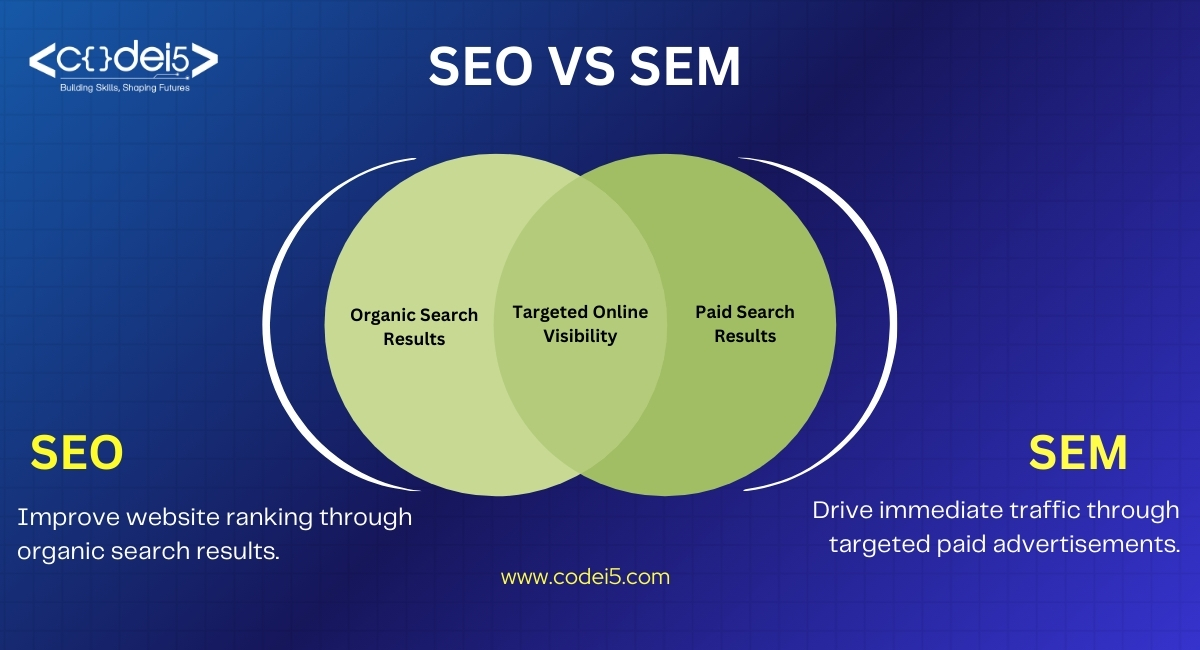
Digital marketing is home to two often-confused terms: Search Engine Marketing (SEM) and Search Engine Optimization (SEO). In the field of digital marketing, these two phrases are frequently used interchangeably. While they all have the same goal of increasing online visibility and driving visitors to your website, their approaches, benefits, and applications vary greatly.
In this blog post, we’ll explore the differences between SEM and SEO, and discuss how to use both effectively to boost your online presence.
What is SEM?
Search Engine Marketing (SEM) is a type of digital marketing in which you promote your website using sponsored adverts on search engines such as Google, Bing, and Yahoo. SEM is also known as Pay-Per-Click (PPC) marketing, which means you pay every time a user clicks on your ad. SEM programs are designed to produce instant results by generating traffic, leads, and sales.
Benefits of SEM
- Fast results: SEM delivers immediate traffic and leads.
- Targeted advertising: Reach your target audience with precision.
- Measurable ROI: Track your ad spend and conversions easily.
What is SEO?
Search Engine Optimisation (SEO) is a digital marketing method that aims to improve your website’s ranking in organic search engine results pages. SEO increases the visibility and reputation of your website by employing a range of tactics such as keyword research, on-page optimization, link building, and content creation.
Benefits of SEO
- Long-term results: SEO drives sustainable traffic and leads.
- Cost-effective: No ongoing ad spend required.
- Brand credibility:Establish your brand’s authority in your niche.
Key Differences Between SEM and SEO:
- Traffic Cost: SEM costs money, while SEO is free
- Marketing Type: SEM uses both inbound and outbound marketing, while SEO uses inbound marketing
- Time to Results: SEM yields short-term results, while SEO takes time to deliver results
- Included Channels: SEM includes PPC, SEO, display, local, and more, while SEO only includes SEO
- Targeting: SEM allows for specific targeting options (e.g. demographics, interests), while SEO targets users searching for specific keywords
- Ad Control: SEM gives you complete control over ad copy, landing pages, and targeting, while SEO relies on optimized website content and structure
- Measuring Success: SEM is easily measurable through ad metrics (e.g. CPC, CTR), while SEO success is measured through rankings, organic traffic, and conversions
- Competition: SEM competition is based on ad auction bids, while SEO competition is based on website authority and relevance
- Content Creation: SEM requires ad copy and landing pages, while SEO requires high-quality, keyword-optimized website content
- Long-term Value: SEM provides short-term results, while SEO builds long-term credibility and sustainability
Understanding these distinctions enables you to develop a comprehensive digital marketing plan that uses the capabilities of both SEM and SEO to increase traffic, leads, and sales.
How to Set Up a Successful SEM Campaign?
- Define your target audience and ad goals
- Choose relevant keywords and ad groups
- Create compelling ad copy and landing pages
- Set bids and budgets for optimal performance
- Monitor and optimize ad performance regularly
Example:A fashion e-commerce company promotes their summer sale with SEM, targeting phrases such as “summer dresses” and “discount code.” They build eye-catching advertising with a clear call-to-action that direct people to a specialized landing page featuring a limited-time offer.
How to Improve Your Website’s SEO
- Conduct keyword research and optimize on-page elements (title tags, meta descriptions, headings).
- Create high-quality, relevant, and consistent content.
- Build high-quality backlinks from authoritative sources
- Optimize website technicalities (page speed, mobile-friendliness, SSL).
- Use Google Search Console and Analytics to track performance.
Example: A health and wellness blog optimizes their website for SEO by creating informative and engaging content around keywords like “mindfulness exercises” and “healthy recipes.” They build backlinks from reputable sources and ensure a user-friendly website experience, resulting in improved search engine rankings and organic traffic.
How to Use SEM and SEO Effectively?
SEM:
- Set clear goals and budgets
- Target specific demographics and interests
- Optimize ad copy and landing pages
- Monitor and measure ad performance
- Use relevant keywords
SEO:
- Conduct thorough keyword research
- Optimize website technicalities (page speed, mobile-friendliness, SSL)
- Improve user experience (clear navigation, relevant content)
- Create high-quality, keyword-optimized content
- Monitor and measure SEO rankings and organic traffic
Combining SEM and SEO:
- Use SEM for immediate results and testing keywords.
- Use SEO for long-term sustainability and credibility
- Combine data from SEM and SEO to refine marketing strategy.
- Use keywords consistently across SEM and SEO efforts.
Conclusion
SEM and SEO are complementary digital marketing strategies that can work together to drive traffic, leads, and sales. Understanding the distinctions and benefits of each allows you to develop a comprehensive internet marketing strategy that meets your company’s goals and budget. Remember that SEM yields quick results, however SEO establishes long-term trust and sustainability. Use both to dominate the search engine landscape and expand your online visibility.







